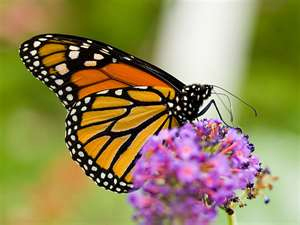 Every year the monarch butterflies of North America go on a remarkable migration, from their summer homes in the rural United States to their wintering grounds in southern Mexico.
Every year the monarch butterflies of North America go on a remarkable migration, from their summer homes in the rural United States to their wintering grounds in southern Mexico.
Chip Taylor, an entomologist at Kansas University, has been tracking them through a project called Monarch Watch, distributing 200,000 tiny stickers each year to schoolchildren and nature lovers who catch the butterflies, tag them and release them. Taylor says the populations have dropped by an average of 40 percent since the beginning of the decade, and he says he thinks he knows why.
A leading culprit, he says, is the widespread adoption of genetically modified crops — strains of corn and soybeans with genes added so they are herbicide-tolerant (H.T. for short). They have been a boon to farmers: The Department of Agriculture says 94 percent of the soybeans grown in the United States are now herbicide-tolerant.
With the new, tougher strains, farmers can spray their fields with chemicals such as glyphosate — the most popular brand is Monsanto’s Roundup — to get rid of weeds without damaging their crops in the process.
The problem, says Taylor, is that milkweed in particular is a perfect habitat for butterflies. There have also been some bad winters and use of other chemicals, but Taylor says the insect population has steadily dropped since 2003. Less habitat, fewer butterflies.
“It’s hard to be absolutely sure about cause and effect, but some of it has to be due to the adoption of H.T. crops,” said Taylor, who along with several colleagues published a paper in the journal Insect Conservation and Diversity.
Farm Chemicals? Or Bad Winters?
There is considerable argument over whether butterfly populations have, in fact, dropped, or just varied widely from year to year. Andrew K. Davis of the University of Georgia published numbers from his own survey: “The data presented here suggest that the population remains stable for now, probably because of the high fecundity of the species and its ability to rebound from small winter numbers.”
And Monsanto, which makes the herbicide Roundup, said, “The evidence is preliminary and disputed,” especially considering variations from state to state. “The knowledge is still evolving whether and how agriculture in Iowa affects Monarch population biology,” it said in an email.
“There are a number of factors entomologists can say affect monarchs to some degree,” Monsanto spokesman Tom Helscher said. “What’s not clear is of all the factors, which is the most important.”
Taylor said he’s convinced something is happening.
“Yes, there’s a lot of seasonal variability, but this is way beyond that,” he said. “You can’t establish the cause for sure, but it’s hard to deny it either.”
He said the best approach for now is to protect patches of milkweed as “way stations” for the butterflies. Two percent of the farmland in the Northeast, he said, is unused — it is buffer between the edges of roads and the edges of fields. Let it be wild, he said, and the butterflies will find it.
But genetically-modified crops, he said, are here to stay: “The path of agriculture is to get more efficient, and we’re not going to stop that.”